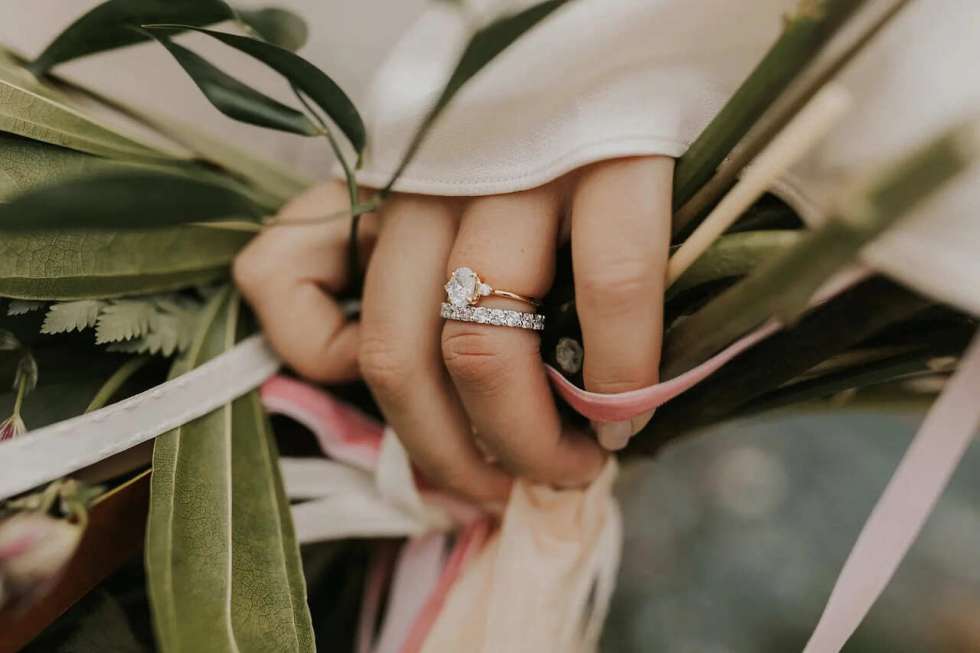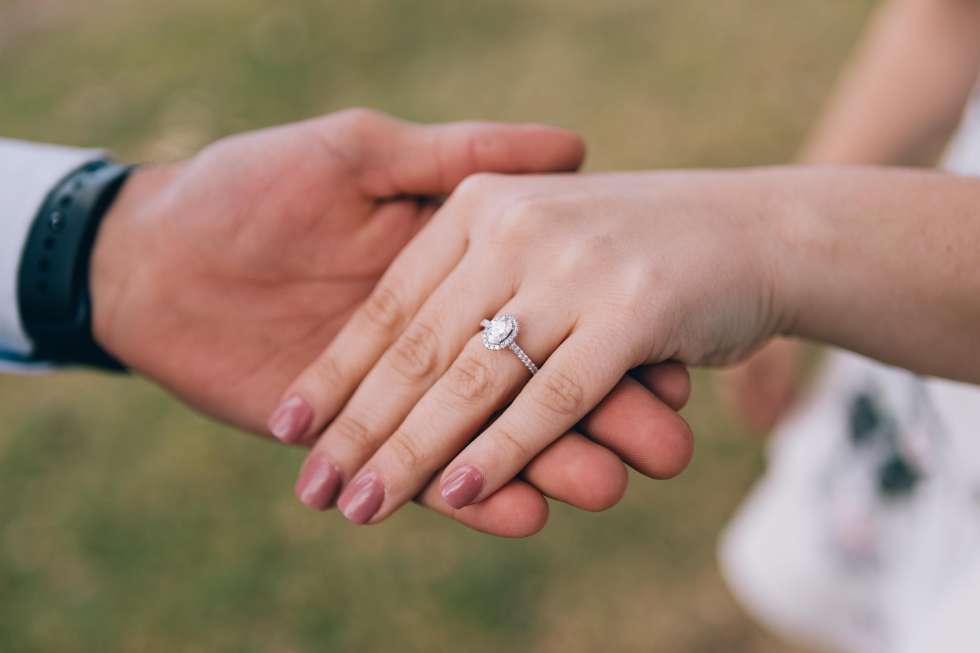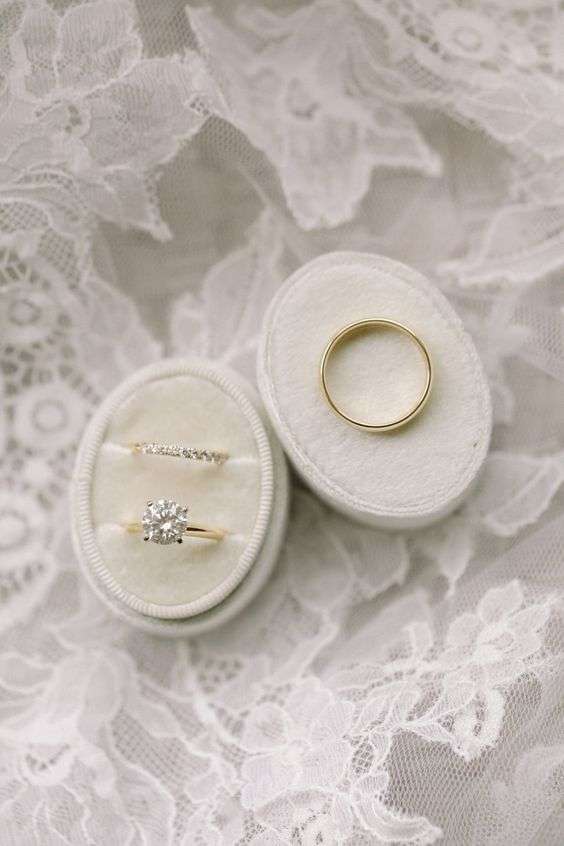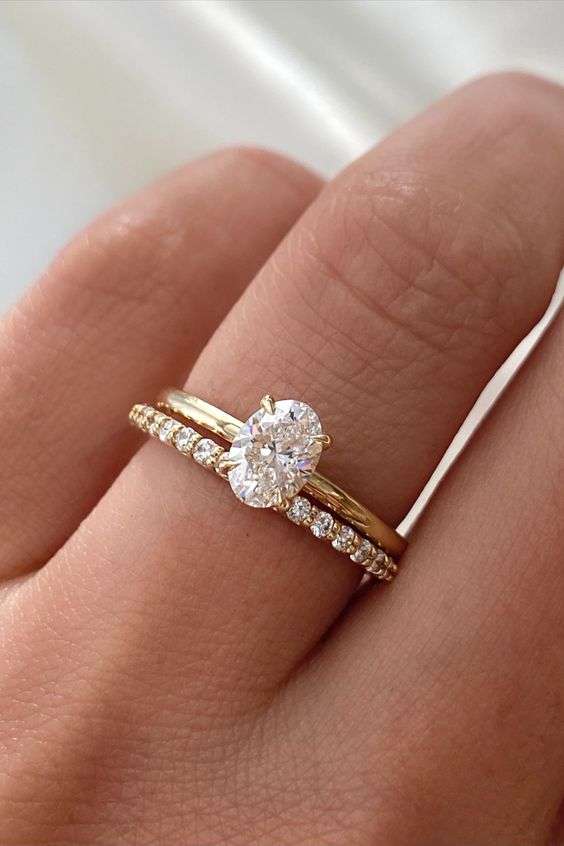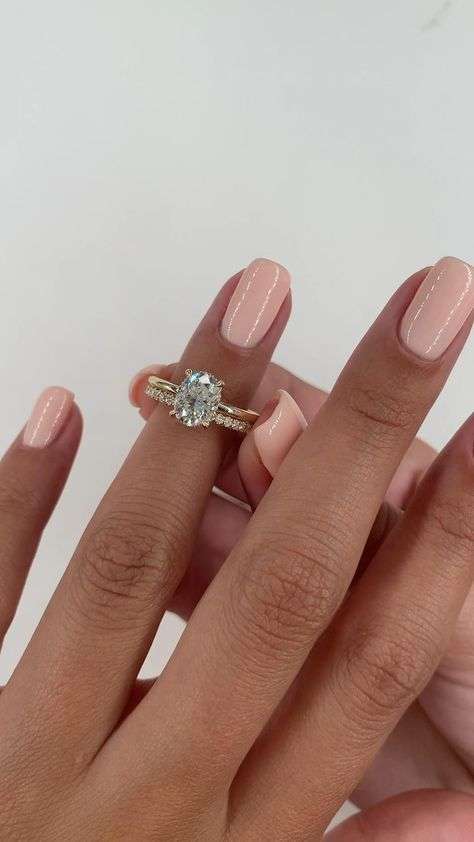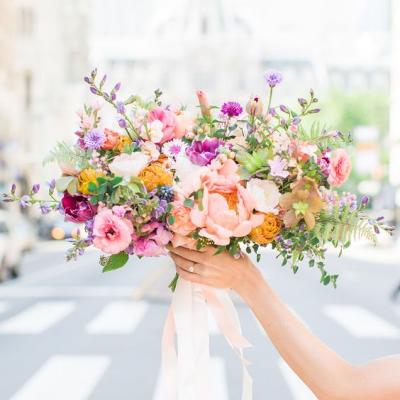What Should I Do with My Engagement Ring on The Day of My Wedding?
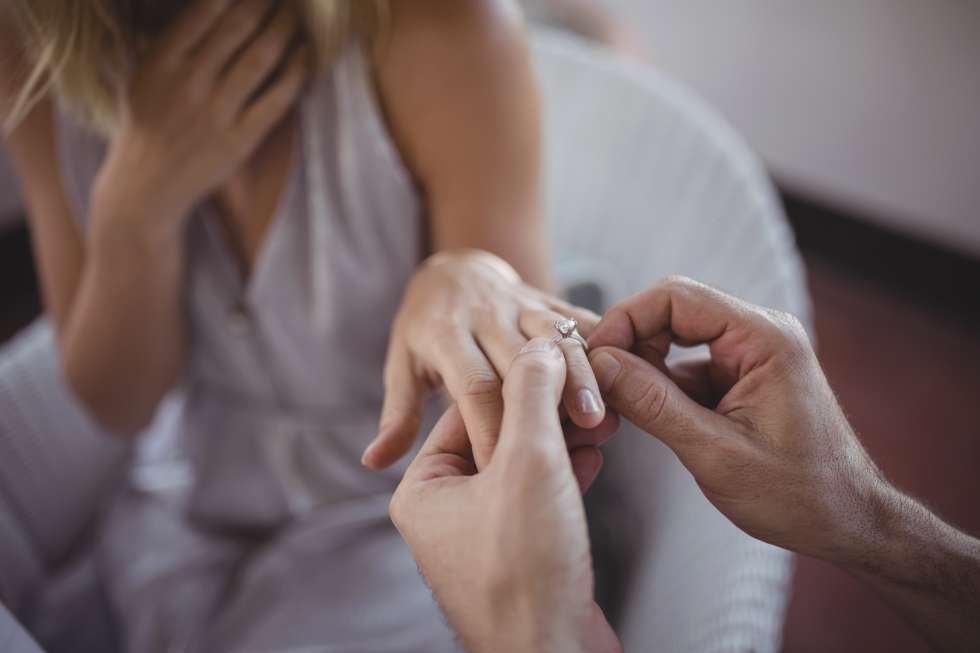
From the sandy dunes of the Arabian Peninsula to the charming towns of Europe, engagement rings are a vital event in a couple's love journey. Beyond gorgeous accessories, these dazzling emblems of commitment hold pledges made beneath a starry sky, aspirations spoken alone, and the joy of a lifelong journey together. As the wedding bells ring and the veil falls, women worldwide wonder what happens to their beloved rings.
Engagement rings in Dubai are usually worn on the right hand until the wedding. This symbolizes a fresh chapter and honors the couple's journey to this momentous day. The husband, full of love and anticipation, gently places the wedding band on the same finger during the vows, symbolizing their increasing love. During the ceremony, both rings console the bride, each expressing a different portion of their love story.
European customs, steeped in history and romance, frequently unfold differently. During the ceremony, brides wear their engagement ring on their left ring finger. After joining, the wedding ring symbolizes lifelong commitment. This custom honors the engagement as a prelude to the grand vow that binds two souls, preserving continuity and legacy. It symbolizes a love that began with a whispered "yes" and became a lifetime vow on the bride's finger.
Traditions are great, but not rules. Inspired by their individuality, modern brides are selecting distinctive, customized alternatives. The engagement ring given to a close friend or family member during the wedding gives a touching touch of love and support beyond the vows. This expression of trust and devotion offers loved ones' support as the couple begins their forever. It also allows the bride to enjoy the moment without worrying about her ring. These moments make the ring more than jewelry, whether her sister holds it close with delight or her closest friend keeps it in her pocket. It connects the bride to the love and support that have led her and will sustain her in her new phase.
The placement of your engagement ring during your wedding is unique. There is no right or wrong answer—only your heart's whispers and desires form your special day. Let your pick represent your love story, whether you follow family traditions, explore new trends that reflect your individuality, or establish your own route. Its brightness and the love and excitement you feel on this special day reflect your journey.
Let your engagement ring tell its tale at the altar, surrounded by love and excitement. A tale about vows maintained, ambitions realized, and the bravery to spend eternity with your partner. May its light lead you to happiness and love forever, whether held by a trusted hand or cuddled against your skin. Remember your journey to this point, hand in hand, ready to create your next everlasting narrative.
Option 1: Wear the engagement ring on a different finger
In the complex web of wedding customs, some ladies choose to put the engagement ring on a different finger. Bridal traditions in the UAE and Europe are notably diverse.
The UAE's cultural traditions include wearing the engagement ring on the right hand until the wedding. This tradition marks the start of a new chapter and honors the union route. The man gingerly sets the wedding band on the same finger throughout the vows, symbolizing developing love. Bringing tradition and the pleasure of the present together allows the bride to experience the soothing presence of both rings, each representing a chapter in their love journey.
While European customs are rich in history and passion, brides are expected to wear their engagement ring on their left ring finger during the ceremony. Adding the wedding ring symbolizes a united commitment. This approach stresses continuity and reverence for legacy, showing the engagement as a forerunner to the magnificent promise that unites two spirits.
Modern brides want to express themselves, so they wear their engagement rings on various fingers throughout the ceremony. This deviation from convention is a purposeful choice to express one's own style and preferences. It acknowledges the changing wedding practices where the bride writes her own story.
The benefits and drawbacks of wearing the engagement ring on a different finger depend on emotional significance and pain. To retain the meaning of their engagement ring, some ladies choose this variation. They place it on a different finger, usually on the other hand, to keep the engagement and wedding bands in focus throughout the ceremony. This separation lets each ring tell its own tale, commemorating the proposal for marriage.
However, brides contemplating this choice worry about pain. Engagement rings with complex settings or bigger stones may seem awkward on the same finger as the wedding band. An alternate finger lets both rings shine without compromising the bride's comfort throughout the ceremony. This option is preferred by individuals who value ease of movement and a smooth flow at this important time.
Despite its convenience, wearing the engagement ring on a different finger is difficult. One must avoid aesthetic clashes between the engagement ring and wedding band. Bold, elaborate ring designs may clash on neighboring fingers. The brides must balance visual harmony and unique expression with the two rings.
Option 2: Have someone else hold onto the engagement ring
Brides who want a unique wedding might give their engagement ring to a loved one. This variation from the traditional ring arrangement is influenced by the rich traditions of the UAE and Europe.
Entrusting the engagement ring to a trusted person is anchored in family and friendship in the UAE, where cultural norms are strongly ingrained in marital ceremonies. It shows how the couple's lives are intertwined with their loved ones. The bride gently gives her valuable ring, sometimes a brilliant heirloom, to a close friend or family member before the vows. This symbolic deed adds emotional depth to the ceremony by expressing the couple's communal support and love as they begin their marriage.
With their timeless elegance and focus on family relationships, European customs replicate the feeling of giving the engagement ring to a loved one during the ceremony. In this case, a loved one holds the sign of commitment with regard and care until the vows are exchanged. This stresses the significance of family and enables the bride to completely experience the event without worrying about protecting her prized gift.
The benefits and drawbacks of having someone else hold the engagement ring during the ceremony are many. Peace of mind is the main benefit. Entrusting the ring to a trusted friend or family member reduces the bride's worries about misplacement or damage during the ceremony. This enables her to concentrate on the vows, the emotional meaning, and the pleasure of the union without worrying about the physical commitment.
This option has risks, including the danger of ring loss or damage. Despite trusting the custodian, wedding ceremonies might be unexpected, putting the ring at risk. Accidents are uncommon, but losing or ruining important jewelry, frequently with emotional significance, is a genuine worry. Careful preparation and communication are essential to mitigate this risk and ensure that the chosen custodian understands their duty and protects the ring during the ceremony.
In essence, having someone else carry the engagement ring during the wedding ceremony is a touching option that combines cultural and personal values. It symbolizes love, family, and friendship. It gives the bride peace of mind and lets her enjoy the ceremony's emotional depth, but risks of loss or damage need careful preparation and communication. This option shows how wedding rituals are changing, allowing women to tell their own tale that represents their beliefs and relationships.
Option 3: Incorporate the engagement ring into the wedding band
The fusion of the engagement ring and wedding band into a single, indivisible piece of jewelry is a modern option for brides considering the location of their engagement ring during the ceremony. This contemporary alternative blends UAE culture and European tradition, adding symbolism, convenience, and cost to marriage rites.
Some UAE women combine their engagement and wedding rings, blending ethnic customs with marital symbols. Making a single piece signifies the continuation of love and dedication between the past and future. As the bride exchanges vows, her fused rings symbolize the peaceful merging of two lives, two families, and rich traditions.
Convenience vs. Cost: Fusing Your Engagement Ring and Wedding Band
|
Feature |
Convenience |
Cost |
|
Ease of wear |
There is no need to manage separate rings, eliminating risk of misplacement or damage |
It can be more expensive than buying separate bands |
|
Practicality |
Ideal for active brides seeking a carefree celebration |
Complex designs and materials can drive up the cost |
|
Symbolism |
Represents the merging of your engagement and marriage journeys into one seamless commitment |
Might not suit those who cherish their engagement ring as an individual piece |
|
Uniqueness |
Creates a one-of-a-kind piece of jewelry reflecting your love story |
Custom design and alterations can add to the cost |
|
Future wearability |
May require further alterations if you wish to wear the engagement ring solo later |
Less flexibility compared to separate bands |
In timeless Europe, incorporating the engagement ring into the wedding band modernizes traditional rituals. Merging the rings creates visual consistency and combines history with modern beauty. The bride's one undivided ring throughout the wedding symbolizes her lifetime vow to eternal love.
As with any major wedding decision, incorporating the engagement ring into the wedding band has benefits and downsides, complicating the decision-making process. Its convenience is a major benefit. The fused ring fits the bride's finger without switching or stacking bands. Brides who value simplicity and elegance would love this option.
Adding the engagement ring to the wedding band might also save money. The initial cost of integrating the rings may be higher, but the long-term financial benefits may be greater. A single, integrated component may save the couple money on a wedding ring. However, this must be balanced against the emotional importance of keeping the engagement ring and wedding band separate.
However, downsides should be considered. Most important is fusion's irreversibility. Separating fused rings is complicated and expensive. This lack of flexibility may make it difficult for the bride to wear the engagement ring and wedding band separately for emotional or other reasons.
The aesthetics of the merging ring must also be considered. Engagement rings with elaborate patterns or huge stones may not fit a wedding band. To create a unified and attractive item that blends the individual qualities of both rings, careful planning and consultation with an experienced jeweler are essential.
Other Considerations
As you finish the wedding preparations and butterflies fly in your stomach, a sensitive issue arises: where will your beloved engagement ring be during the ceremony? Like a weathered tapestry, tradition portrays a recognizable image on your left ring finger. Some brides, like courageous painters picking their own palette, choose a different route based on cultural influences, personal tastes, and their love story.
Choosing the engagement ring's position during the ceremony is a delicate balance between personal preferences and family customs for UAE women. Families often wear the engagement band on the right hand until the wedding. The husband, filled with love, delicately puts the wedding band onto the same finger during the vows, producing a lovely, layered sign of their developing love. This wonderful combination of tradition and personal expression lets the bride feel both rings comfort her during the ceremony, each telling a chapter in their love story.
In Europe, with its rich traditions, brides wear their engagement ring on their left ring finger during the ceremony. After joining, the wedding ring symbolizes eternal commitment. This ritual honors the engagement as a prelude to the big oath that unites two souls and shows continuity and reverence for the legacy. Modern brides, emboldened by individualism, often choose distinctive options that represent their stories and tastes.
|
Option |
Pros |
Cons |
Consideration for UAE & European Traditions |
|
Wear on a different finger |
- Comfortable and practical for active brides |
- Departure from traditional placement on ring finger |
- Less symbolic meaning |
|
Entrust to a friend or family member |
- Heartwarming gesture of trust and support |
- Potential risk of loss or damage |
- May be hesitant to relinquish ring |
|
Fuse with wedding band |
- Convenient, no fumbling with rings |
- Can be more expensive |
- May not be budget-friendly |
|
Wear engagement ring traditionally |
- Honors tradition and heritage |
- Might feel unoriginal for some |
- Conforms to UAE custom of wearing on right hand before ceremony |
Your Sparkler's Journey: Where Does Your Engagement Ring Rest on Your Wedding Day?
The most essential thing is picking a route that connects with your love story and makes your heart sing, whether you want to include a beloved item or a design that matches your particular taste. You might give your ring to a loved one during the ceremony, giving a touching element of trust and support to your everlasting journey. You might even combine both rings for convenience and emotion, producing a masterpiece that reflects your love's growth.
After the ceremony, the adventure continues. After the festivities and emotions subside, your engagement ring stays as your companion. Caring for it gently keeps it a brilliant sign of your affection for years. Regular cleaning with a soft cloth and warm water keeps it shiny, but expert cleaning every few years addresses underlying issues. To avoid scratches, put it in a soft purse or jewelry box while not wearing.
Conclusion
The excitement of your wedding day raises a sensitive question: where will your engagement ring go? Tradition in the UAE suggests wearing it on the right hand until the vows, but European norms suggest wearing it on the left. Your choice is unconstrained. Instead, a tapestry of alternatives with distinct emotion, pragmatism, and personal expression emerges.
For busy brides who want worry-free festivities, wearing the ring on the middle or index finger is comfortable and convenient. Some may find it a deviation from tradition. Leaving your ring with a trusted friend or family member offers a touching dimension of trust and support, letting you enjoy the ceremony.
However, loss or damage must be considered. Fusing your engagement ring and wedding band into one stunning sign of your love's progression is wonderful, but consider the expense and future changes. Remember, no solution fits everybody. Let your choice reflect your love story and make your heart sing, whether you follow traditions, experiment, or create your own route. You may add a family heirloom to your UAE design to connect past and current love. Imagine your grandma enthusiastically recounting the ring's history, her eyes flashing with excitement. In Europe, you may wear your engagement ring on your left hand to honor your heart. Imagine saying your vows with your dearest friend holding your ring; her presence is a subtle but soothing reminder of your connection.
Finally, you decide. Let your engagement ring whisper its wonderful narrative of love and commitment in its chosen setting, adding another chapter to its story as it begins your everlasting journey together. Celebrate the pleasure, tenderness, and originality of your love story—it makes your wedding day sparkle brighter than any gem. Every element, large or little, should represent that tale, sparkle in honor of the love that brought you together, and bring you joy as you begin your forever together.

